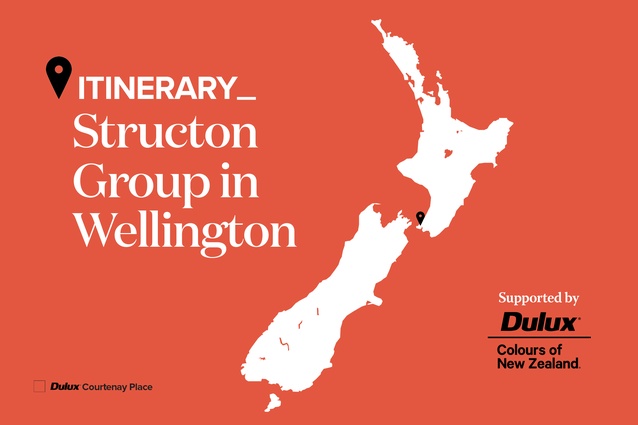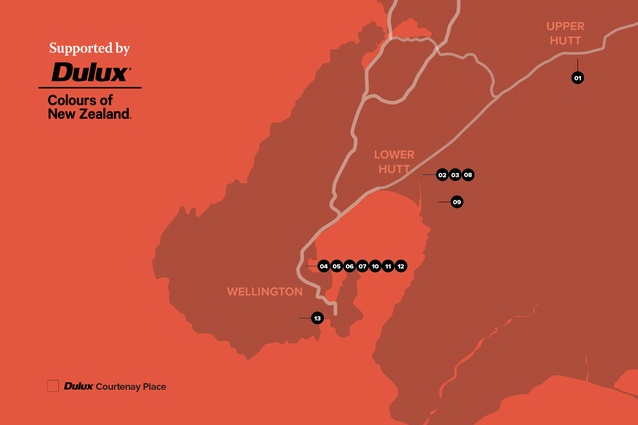Itinerary: Structon Group in Wellington
Andrew Barrie and Ross Brown profile thirteen notable buildings produced by Structon Group in the city of Wellington, documenting the large firm's stamp on the region's architectural history.
We tend to think of larger design practices, particularly those where the identity of the firm eclipses that of any individual designer, as producing work that is less distinctive or adventurous. Structon Group, like all large firms, followed the big flows of architectural evolution. However, in a streak spanning the second half of last century, the firm was home to a succession of designers who seemed consistently bolder and better informed than were those of rival firms. Structon’s high modernism tended towards a voluptuous Latin mode rather than boxy, Californian cool. Its high-tech style sidestepped frilly space-frame fetishes for forms that were machinic and sculptural, and their PoMo was sharp and shapely rather than podgy and pastel.
Structon was one of a number of team-based practices that emerged in the post-war period. The country was undergoing a general building boom but such firms could meet the specific and complex new challenges posed by large tower blocks, hotels, university buildings and so on. These firms offered different mixes of skills. Kingston, Reynolds, Thom & Allardice emerged in the 1950s, offering a vast range of engineering disciplines, town planning and architecture. Ex-KRTA staff formed the core of JASMaD in the 1960s, offering a sweep of design disciplines, from architecture and interiors through to environmental impact reports, post-occupancy evaluation, and other types of design research and analysis. Structon’s particular offering was architectural design and the related engineering disciplines; they made buildings.
The firm emerged from an impeccable establishment design lineage, passing back through important figures such as John Sydney Swan, Frederick de Jersey Clere, and Joseph Dawson of Dawson & King. The firm had its architectural statesmen: Ron Muston led the firm to two NZIA Gold Medals; Keith Cooper produced much of the swish design we still admire; and Ross Brown set the design direction through the buoyant years of the 1970s and 1980s. Intriguingly, though, much of the firm’s import emerged not from gentlemanly bona fides but as a place that gave room to youngsters. Ian Athfield, who was made a partner just two years after joining the firm, worked alongside future southern maestro John Blair. SkyTower architect Gordon Moller had a summer job, Māori trailblazer Rewi Thompson was a draughtsman for a spell and future NZIA Gold Medallist Stuart Gardyne produced high-profile commercial projects.
Structon eventually unravelled in the financial downturn that followed the financial crash of 1987. Stuart Gardyne took leave to design City Gallery Wellington. Ross Brown was lured to Auckland to work with Moller Architects on SkyCity. Many other multidisciplinary firms underwent similarly drastic change around that time. JASMaD narrowed its offering and became Jasmax in the late 1980s while KRTA was absorbed into a larger engineering firm in the 1990s. Lots of our larger firms are currently adding disciplinary strings to their bows but, if history is any guide, it is hard to maintain. Disciplines don’t necessarily share values. Not all customers want all services, and it is hard to maintain consistent quality and profitability across different disciplines. Lines of fracture appear. The lesson of Structon Group is that talent, even when just passing through, trumps consistency.
THE ITINERARY
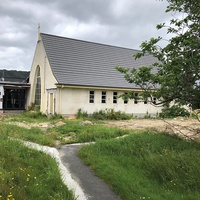
1. 1950 – St Joseph’s Orphanage
17 Gibbons Street, Upper Hutt
A Catholic orphanage, this project included several residential wings but the key element was a concrete chapel that features swooping arches on the end walls — perhaps the closest Upper Hutt ever came to Brazilian modernism. The project was awarded the NZIA Gold Medal in 1952. In the 1970s, small retirement home villas began being added to the site and, in the 1980s, the orphanage became a rest home for retired nuns. Jasmax is currently building a new facility in what was the entry court — the orphanage wings may not survive much longer but the chapel is being retained. Refer NZIA Journal Sept 1953.
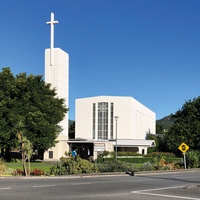
2. 1953 – St James’ Anglican Church
71 Woburn Road, Lower Hutt
Ron Muston’s most admired project, St James earned Structon a second NZIA Gold Medal in 1954. Sited dramatically on a main approach to the city centre, it is a simple composition — a crisp, triple-height nave volume and an urban-scaled bell tower rise up from a skirt of single-storey ancillary spaces. Internally, the repetition and subtle geometry of the structural frame enliven the brightly lit nave. As Bill McKay asserts, “At St James, the values of contemporary Christianity paralleled the modernist virtues of the functional and practical”. Refer Bill McKay, Worship: A History of New Zealand Church Design (Auckland: Godwit, 2015)

3. 1956 –War Memorial Library and Little Theatre
Queens Drive, Lower Hutt
This high modernist building forms part of the Lower Hutt Civic Centre redevelopment. In Long Live the Modern, Ian Bowman explains that “After the war, the Lower Hutt mayor, J. W. Andrews, and the newly appointed city planner, R.D.H. Hill, recognised an urgent need to re-plan the city centre, to overcome traffic congestion, haphazard growth, rundown buildings and Council accommodation spread over a number of old buildings”. The redevelopment also included the Town Hall and Administration Block (1957) and the Horticultural Hall (1959), both by King, Cook & Dawson. Structon’s The Dowse Art Museum was added later (1971). Refer NZIA Journal April 1955.

4. 1961 – NZ Racing Conference Building
85 Victoria Street, Wellington
Built for the organisation that oversaw thoroughbred horse racing nationally — note the horseshoe decorations on the balustrades — the project makes the most of an acute corner site. A stack of curved balconies turns the corner and the undulating concrete canopy sheltering glass shop fronts continues the curvilinearity. Attributed to Keith Cooper, the design exhibits what is, for this country, an unusually exuberant form of modernism; the project was dismissed as an ‘over-dressed old lady’. A penthouse was added in 1974 and the building survived threats of demolition in the 1980s, receiving an NZIA Wellington 25 Year Award in 1990. Refer Architecture NZ Nov/Dec 1990.
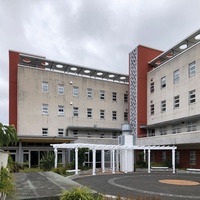
5. 1961 –St Mary’s Convent
15 Guildford Terrace, Thorndon
One of Muston’s last projects, this convent served the Sisters of Mercy, who staff the long-established Catholic girls’ school next door (see listing 11). The composition was formed in crisp volumes of white plaster and textured brick, with stripes of breeze-block-type fenestration and rooftop sunshades giving the complex a distinct tropical flavour. Following established patterns, the buildings were wrapped around walled garden courtyards, created for exercise and contemplation. This lower level has now been refurbished as a conference centre and a stylish chapel, which was part of the original convent complex, has recently been demolished. Refer NZIA Journal June 1966.
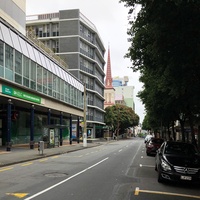
6. 1966 – Education House
178 Willis Street, Wellington
Sporting a distinctive cranked frontage, this seven-storey office building was built for the New Zealand Educational Institute (NZEI), the body that represents teachers in state schools. The NZEI occupied the top floor, with the rest of the building serving as an investment for the organisation. Another larger tower — also by Structon — was built at the rear in the 1970s and the complex is now student accommodation. Central Wellington is dotted with Structon-designed office towers — another gem is the National Bank Building (1969) at 17 Featherston Street, given particular note as an Athfield-led project. Refer Home & Building April 1970.
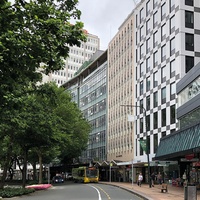
7. 1966 – Manchester Unity Building
120 Lambton Quay, Wellington
This building was sited next to Plischke & Firth’s curtain-walled Massey House (1952) and its clients explicitly precluded the use of a glass frontage. This led to the pleated concrete canopies and the tiled frontage, with its distinctive diamond-shaped — some say coffin-shaped — windows. The highly patterned frontage also served to mask the fact that the scheme tucked an extra floor into the same height as the adjacent Massey House. Pop around to see the frontage on The Terrace but, out of sight from passers-by on both streets, a glassy, rooftop boardroom was tucked under a pleated roof. Refer NZIA Journal April 1966.
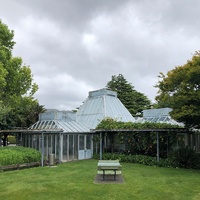
8. 1968 – Gibbes Watson Conservatory
2 Myrtle Street, Lower Hutt
Located near the Lower Hutt Civic Centre, this site was originally considered for The Dowse. Completed the year Ian Athfield departed Structon, this project was designed by Ath and John Blair. The building was composed as a series of glass pavilions, each surmounted by a pyramidal glass roof. One pavilion serves as an entry to three more pavilions, respectively displaying tropical, subtropical and temperate plants. A solid fifth pavilion to the rear contains heating equipment. Steel-framed pergolas covered in vines, which seem to be a later addition, now soften the geometry. It’s looking a bit unloved at present. Refer NZIA Journal April 1970.
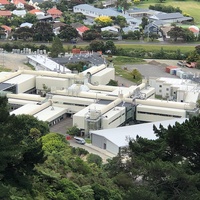
9. 1983 – Physics and Engineering Laboratory
69 Gracefield Road, Gracefield
This complex of workshops and laboratories was designed for the Department of Scientific and Industrial Research, then the government’s primary means of supporting technological innovation. The key need was for flexibility, which was provided by Ross Brown’s moon-base-like arrangement of ‘loose fit’ structures, nodes and courtyards. The high-tech composition was completed by externally expressed services, originally bright red. The complex is now home to the VUW Robinson Research Institute. The project has received multiple NZIA awards – a Wellington Branch Award in 1984, a National Award in 1985 and an Enduring Architecture Award in 2008. Refer NZIA Journal June 1977 and NZ Architect 1, 1983.
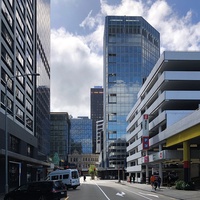
10. 1980, 1984 – Colonial Mutual Life Building
117 Customhouse Quay, Wellington
Built in two stages under Ross Brown’s leadership, this sculptural, mirror-glass complex replaced an art-deco office tower by Melbourne-based Hennessy & Hennessy, the construction of which had been overseen by Structon antecedent Swan & Lavelle. The 18-storey tower was a first stage, with the second stage intended to be a refurbishment of the art-deco tower. However, the clients eventually decided a refurbishment would be unsatisfactory and required a second phase to match the first. The project received NZIA Branch and National Awards in 1985, and an NZIA Wellington Award for Enduring Architecture in 2007. Refer Architecture NZ Dec 1976.

11. 1986 – St Mary’s College
15 Guildford Terrace, Thorndon
The redevelopment of the College began in 1975, with the pushing through of the adjacent Wellington motorway and in response to increased earthquake-strengthening standards. It took place in five stages, resulting in connected gymnasium, administration and teaching blocks. Clere & Clere’s old school hall (1930) was partially demolished with a new concrete structure added to reinforce and extend the original building. Various stages won NZIA Branch Awards in 1981 and 1986. Refer Architecture NZ Mar/April 1986 and May/June 1987. Just down Guildford Terrace at 44 Hill Street is the Ross Brown-designed British High Commission (1990), an essay in postmodernism. Refer Architecture NZ Sept/Oct 1990.
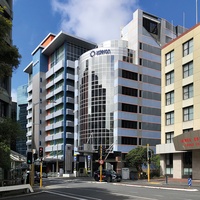
12. 1988 – Sun Alliance House
139 The Terrace, Wellington
Designed by a young Stuart Gardyne, this office building sits on a tricky wedge-shaped site, and had to squeeze a vehicle and pedestrian entry into its narrow street frontage. The solution is a sophisticated composition — horizontal-striped side walls sandwiching a façade of tautly curved glazing, the entrance enlivened by an angular entrance canopy. Completing the reading of the building as a condensed cityscape, entry is a compressed route that steps and winds up into the building like a laneway. The project received an NZIA National Award in a special Urban Context category in 1989. Refer Architecture NZ May/June 1989.
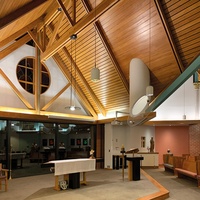
13. 1991 – Chapel of Our Lady’s Home of Compassion
2 Rhine Street, Island Bay
The last part of a 15-year redevelopment of the Home — including hospital, convent, administration, archives and accommodation — led by Ross Brown, the chapel was intended as the high point. It was designed with artist John Drawbridge (stained glass and stations of the cross) to create an aura of silence and reflection. Bestowing an NZIA Branch Award in 1991, the jury wrote, “An air of serenity and peace appropriate to worship and solitude has been achieved by a sensitive selection of materials, the use of existing elements and a successful balance of natural light. The whole is given power and focus by the floor to ceiling windows facing out onto the valley.”
FIRMOGRAPHY
Structon emerged from the partnership of John Sydney Swan and William Lavelle. Swan began his prolific career practising with Wellington maestro Frederick de Jersey Clere in the 1880s, eventually setting up a partnership with Lavelle in 1935. Swan died in 1936 but the firm continued until 1944 when it combined with Muston & Associates to form Structon Group. The name was a conscious reference to Tecton Group, the radical modernist firm active in London prior to World War II. At its peak, the firm had 120 staff across offices in Wellington, Auckland and Palmerston North. Work spanned the country, including large fire stations in Kilbirnie and Palmerston North, and a string of award-winning regional offices for the Housing Corporation and the Rural Bank (often combined) from Timaru to Gisborne to Manukau City. Structon had 20 office buildings on its books on the day of the stock market crash in 1987.
Refer NZIA Journal Feb 1975 for Lavelle and Muston’s obituaries.
OTHER ADDRESSES
CML Building (1959)
20 Laings Road, Lower Hutt
A sleek office building now being converted to apartments.
Wharenui Apartments (1960)
274 Oriental Parade, Wellington
Structon founder William Lavelle was a resident until his death in 1974.
Christ Church Cathedral (1967)
1 Trafalgar Square, Nelson
Completion of the 1920s’ design.
The Dowse Art Museum (1971)
45 Laings Road, Lower Hutt
Another part of the Civic Centre, the project was altered and extended by Athfield Architects in 2006. Refer NZIA Journal July 1972.
Housing Corporation Offices (1978)
1 Walton Leigh Avenue, Porirua.
Housing Corporation Offices (1979)
5 Osterley Way, Manukau City.
Natwest House (1984)
132 The Terrace, Wellington
Refer NZ Architect 6, 1984.
Former Rural Bank (1986)
16 Bell Street, Whanganui
Winner of a Monier Design Award in 1985 and an NZIA Branch Award in 1987. Refer NZ Architect 6, 1985.
Kitchener Street Building (1990)
36 Kitchener Street, Auckland
NZIA Auckland Branch Award in 1990. Refer Architecture NZ Supplement Nov/Dec 1990.
SOURCES
Structon’s projects were well published in the journals of the times, although there is no particularly good, published survey of even a portion of the practice’s output. David Kernohan’s Wellington’s New Buildings (Wellington: Victoria University Press, 1989) includes several Structon projects, with a smaller subset in John Walsh and Patrick Reynolds’ Wellington Architecture: A Walking Guide (Auckland: Massey University Press, 2022). Geoff Mew and Adrian Humphris’ hefty history of Wellington architects and styles up to 1940, Raupo to Deco (Wellington: Steele Roberts Aoteoara, 2014), includes coverage of William Lavelle and his role in the establishment of Structon. Athfield’s contributions at Structon are covered in Julia Gatley’s Athfield Architects (AUP, 2012) and other Structon projects are covered in Gatley’s Long Live the Modern (AUP, 2008). There is also interesting commentary in David Mitchell and Gillian Chaplin’s The Elegant Shed (Oxford Univ. Press, 1984) and in Terence Hodgson’s Looking at the Architecture of New Zealand (Grantham House Publishing, 1990).

The itinerary series is supported by Dulux Colours of New Zealand. Dulux Colour Specialist Davina Harper has selected a Colours of New Zealand palette based on this itinerary. See the full range and order colour samples here.

